First Maroon War Worksheets
Do you want to save dozens of hours in time? Get your evenings and weekends back? Be able to teach about the First Maroon War to your students?
Our worksheet bundle includes a fact file and printable worksheets and student activities. Perfect for both the classroom and homeschooling!
Resource Examples
Click any of the example images below to view a larger version.
Fact File
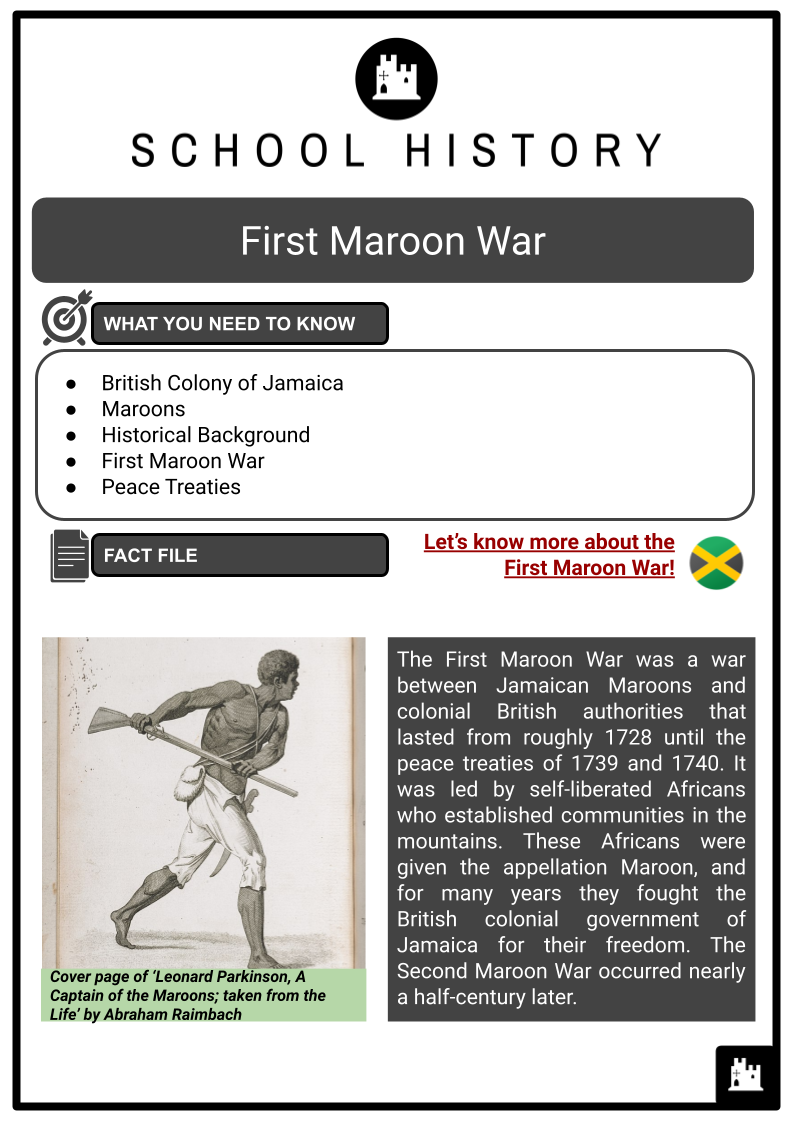
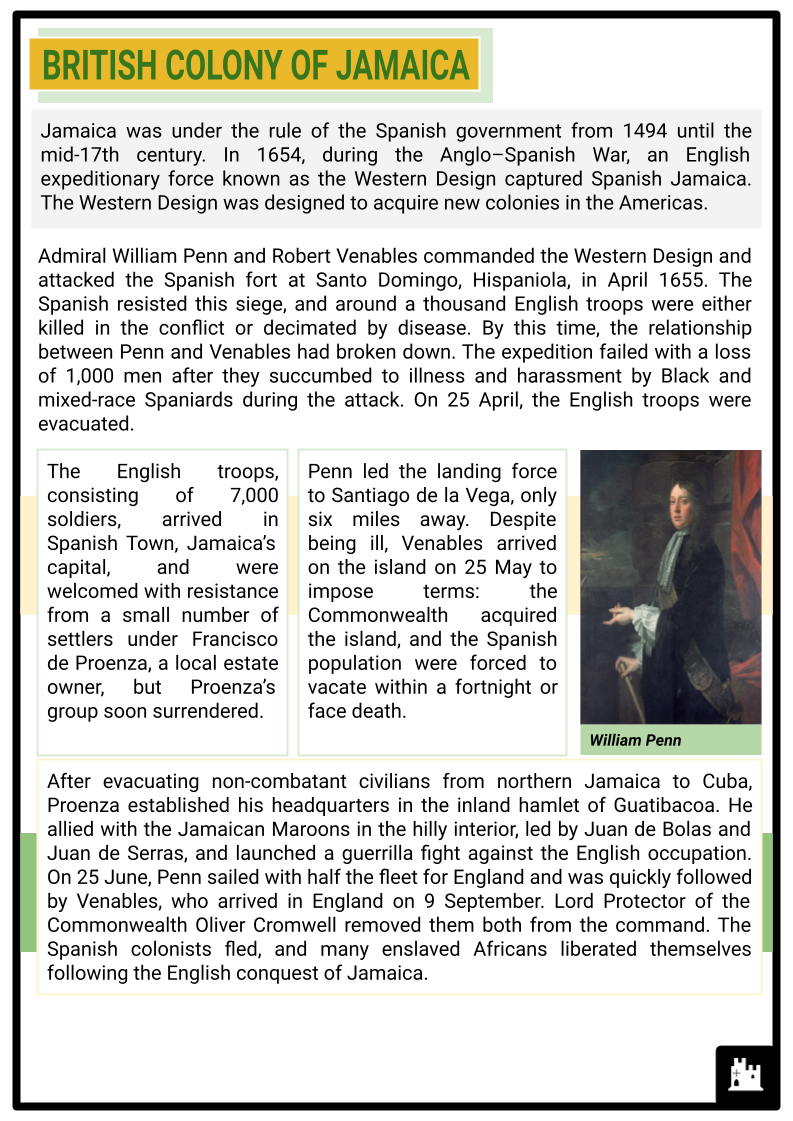
Student Activities
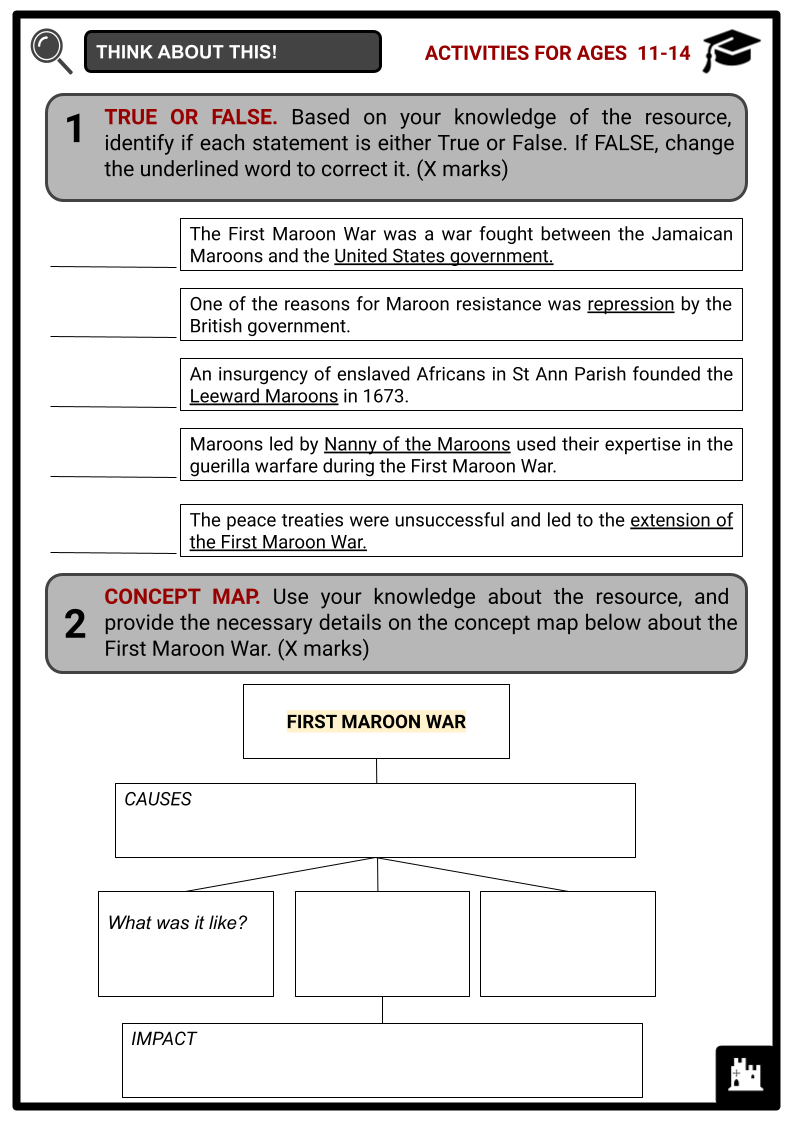
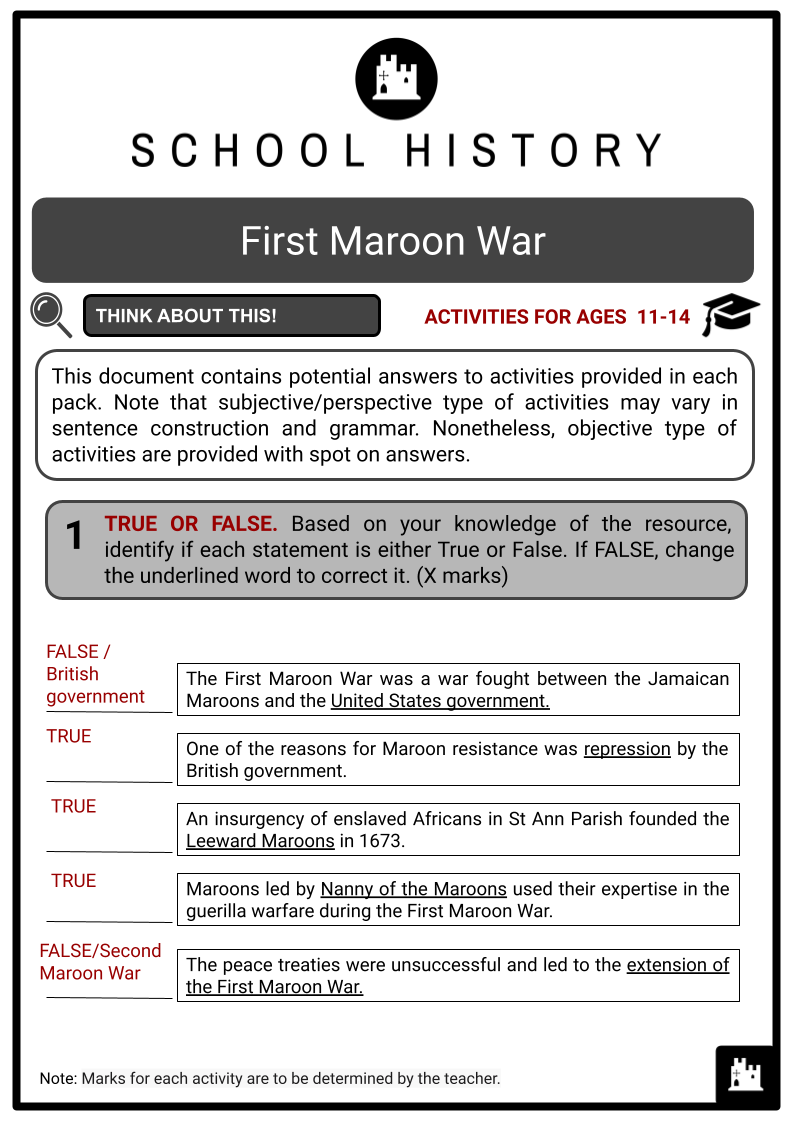
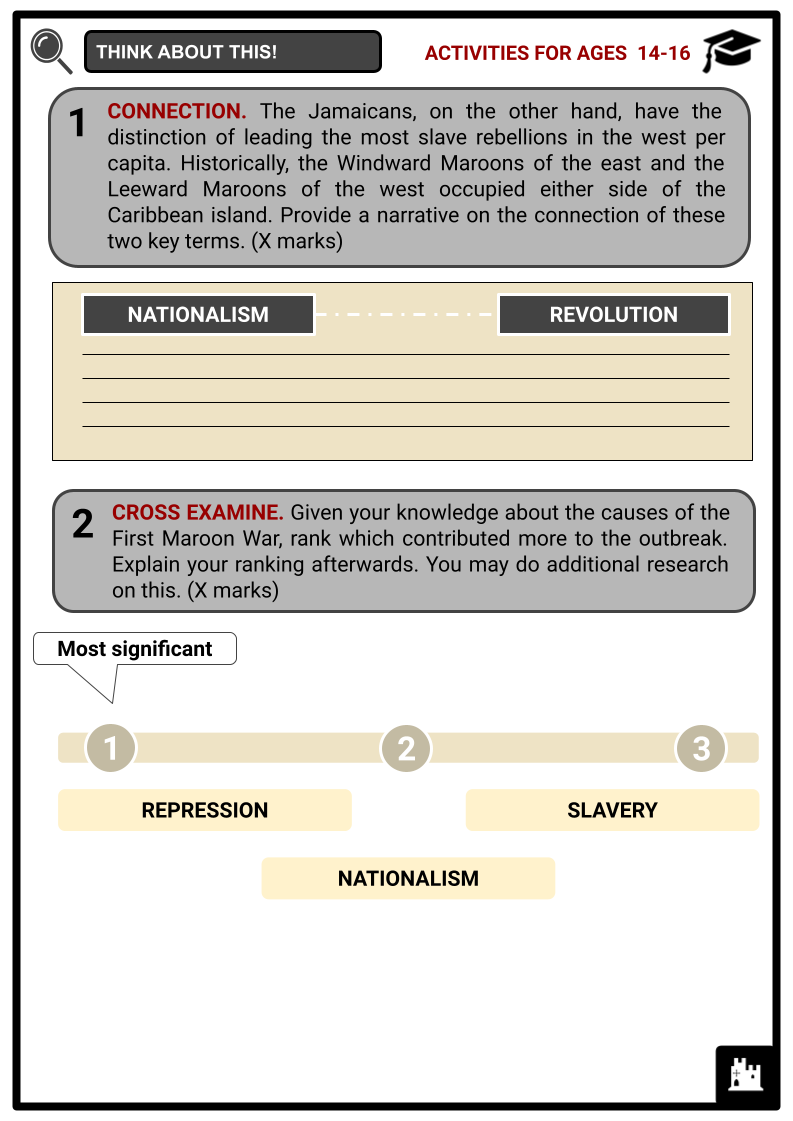
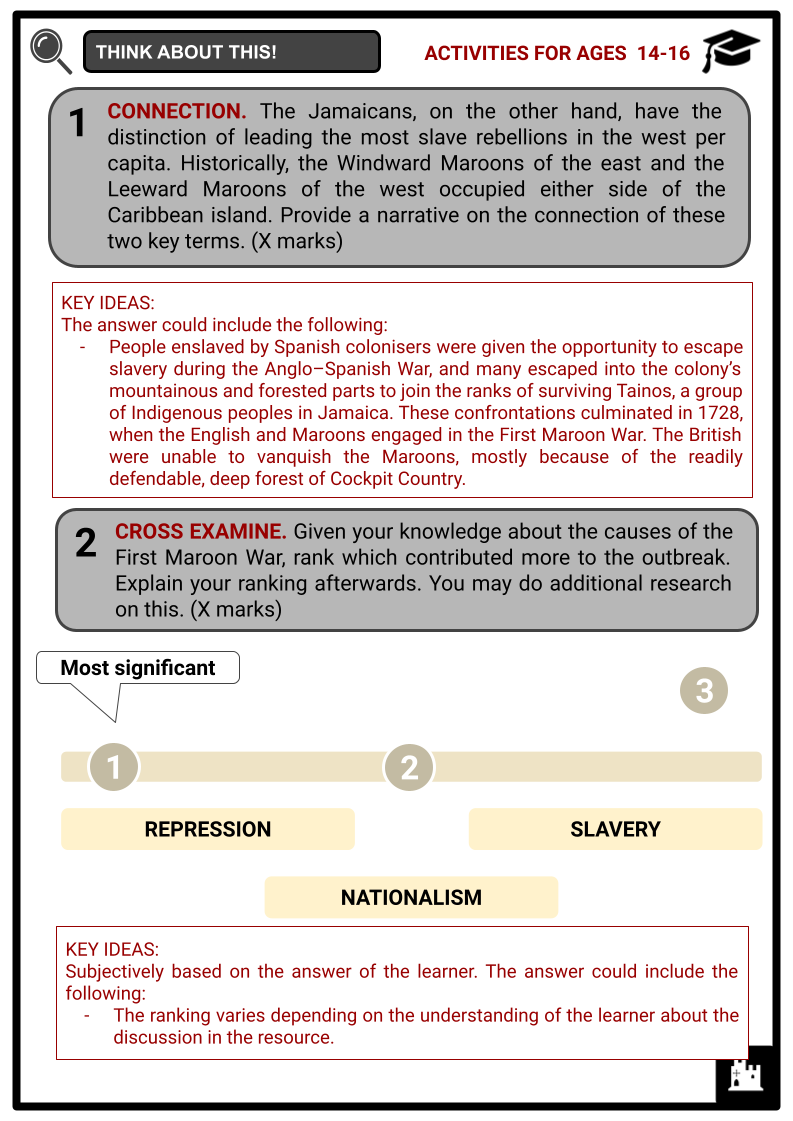
Summary
- British Colony of Jamaica
- Maroons
- Historical Background
- First Maroon War
- Peace Treaties
Key Facts And Information
Let’s know more about the First Maroon War!
The First Maroon War was a war between Jamaican Maroons and colonial British authorities that lasted from roughly 1728 until the peace treaties of 1739 and 1740. It was led by self-liberated Africans who established communities in the mountains. These Africans were given the appellation Maroon, and for many years they fought the British colonial government of Jamaica for their freedom. The Second Maroon War occurred nearly a half-century later.
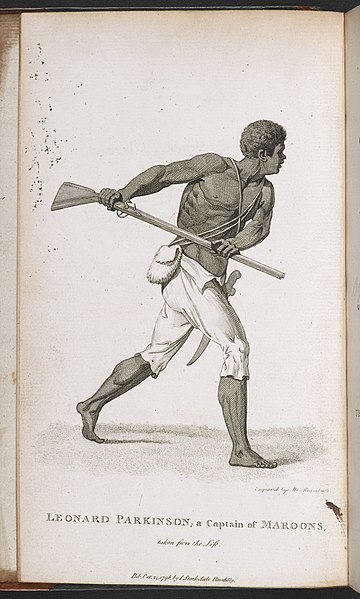
BRITISH COLONY OF JAMAICA
- Jamaica was under the rule of the Spanish government from 1494 until the mid-17th century. In 1654, during the Anglo–Spanish War, an English expeditionary force known as the Western Design captured Spanish Jamaica. The Western Design was designed to acquire new colonies in the Americas.
- Admiral William Penn and Robert Venables commanded the Western Design and attacked the Spanish fort at Santo Domingo, Hispaniola, in April 1655. The Spanish resisted this siege, and around a thousand English troops were either killed in the conflict or decimated by disease. By this time, the relationship between Penn and Venables had broken down. The expedition failed with a loss of 1,000 men after they succumbed to illness and harassment by Black and mixed-race Spaniards during the attack. On 25 April, the English troops were evacuated.
- The English troops, consisting of 7,000 soldiers, arrived in Spanish Town, Jamaica’s capital, and were welcomed with resistance from a small number of settlers under Francisco de Proenza, a local estate owner, but Proenza’s group soon surrendered.
- Penn led the landing force to Santiago de la Vega, only six miles away. Despite being ill, Venables arrived on the island on 25 May to impose terms: the Commonwealth acquired the island, and the Spanish population were forced to vacate within a fortnight or face death.
- After evacuating non-combatant civilians from northern Jamaica to Cuba, Proenza established his headquarters in the inland hamlet of Guatibacoa. He allied with the Jamaican Maroons in the hilly interior, led by Juan de Bolas and Juan de Serras, and launched a guerrilla fight against the English occupation. On 25 June, Penn sailed with half the fleet for England and was quickly followed by Venables, who arrived in England on 9 September. Lord Protector of the Commonwealth Oliver Cromwell removed them both from the command. The Spanish colonists fled, and many enslaved Africans liberated themselves following the English conquest of Jamaica.
- The Spanish liberated the enslaved Africans, who fled into the interior to form free and autonomous communities known as Maroons. Despite its diplomatic efforts, Spain eventually lost the Colony of Jamaica and the Cayman Islands in the Treaty of Madrid in 1670. The island became a tremendously profitable possession under British dominion, producing significant amounts of sugar for export.
MAROONS
- The early Maroons were the descendants of a band of escaped enslaved Africans who sought shelter in the island’s mountainous parts. Later, runaways contributed significantly to their numbers. They sought independence in the mountains, establishing villages and a new way of life. They split into two groups, the Windward and Leeward Maroons.
- The Windward Maroons were located in the island’s eastern half, while the Leeward Maroons were in the island’s western section. Both sites were far from the harsh and dictatorial sugar plantations constructed by the English along the island’s coast. Despite the vast distance between the Maroons and the planters, the two groups often clashed, culminating in the First Maroon War and, later on, the Second Maroon War.
- According to historian Richard Dunn, the origins of the Maroon wars were directly tied to the multiple insurgencies that plagued the island from 1694 to 1704, as well as the number of enslaved people that fled to join the Maroons. Small rebellions erupted on Jamaica’s north coast in 1694, 1702 and 1704. Runaways fleeing the crackdown that followed these revolts attempted to hide in the mountains with other formerly enslaved people.
- According to Dunn, these revolts were the root cause of the war. Other elements, particularly the planters’ unreasonable aggressiveness towards the Maroons, also played a role. The Maroons began to lose momentum on the little islands as planters took over more territory for cultivation. Only on the larger islands were organised Maroon bands able to thrive through agricultural farming and hunting. Seeking to distance themselves from colonisers, the Maroons rose to power despite rising hostility. They plundered and pillaged estates and tormented planters until the planters became concerned about an uprising.
HISTORICAL BACKGROUND
- The Maroons, specifically the Windward Maroons, together with the Amerindian people, established communities in the mountains that later became known as the Blue Mountains. According to Orlando Patterson, a Jamaican-American historian and sociologist, the white population on the island of Jamaica grew to over 12,000 people between 1655 and 1661.
- Only a little more than 3,000 people remained in 1662. Because British forces were unable to take control of the entire island, the Maroons retained control of a substantial portion of it, particularly in the rough interior. For decades, there were conflicts between the British and the Maroons, as well as intermittent revolts by enslaved people. Several further rebellions increased the size of the Leeward Maroons.
- Notably, in 1690, 400 enslaved Africans revolted at Sutton’s farm in Clarendon Parish, Jamaica, significantly strengthening the Leeward Maroons.
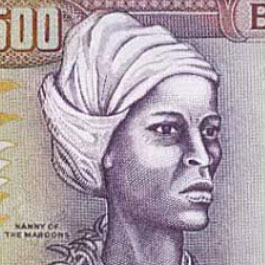
- The First Maroon War lasted from 1728 to 1740, and the Maroon leadership at this time included Nanny of the Maroons, who was recognised for her expertise in guerrilla warfare, Quao in the Windward Maroons, and Cudjoe and Accompong in the Leeward Maroons.
- A number of Maroon commanders, including Welcome and Jeddo for Nanny Town, fought under their command.
FIRST MAROON WAR
- The British dispatched more troops to Jamaica in September 1728, shifting the balance of power away from the Windward Maroons. At the same time, the British dispatched a new governor to Jamaica that year, Major-General Robert Hunter, and the conflict with the Maroons worsened under his administration.
- According to historian Bev Carey, one of the Maroon captains, a man named Jeddo, who is celebrated as a brave warrior by the Maroons of Moore Town, led an attack on the northeastern town of Port Antonio a year later, and when the British soldiers under Lieutenant Soaper tried to pursue them, the Maroons caught them off guard. Nanny’s lieutenant would have been Jeddo.
- The Maroons adopted guerrilla tactics during the First Maroon War to inflict heavy casualties on the colonial forces in terms of both personnel and expenditure. Soaper led a huge force against the Windward Maroons in 1730, but the Maroons, led by Nanny and Quao, beat the militia once more. The following year, two more battalions arrived on Jamaica to aid Hunter in his war against the Maroons.
- Hunter dispatched three troops of soldiers against the Windward Maroons in 1732, and they took over Nanny Town when the Maroons, led by Nanny, fled further into the Blue Mountains. Nanny Town’s occupation was costly, and Hunter finally recalled the militia, allowing the Maroons to retake their town without a struggle.
- Hunter sent a party of British seamen against the Windward Maroons the following year, but they were defeated. Nanny Town’s occupation was costly, and Hunter finally recalled the militia, allowing the Maroons to retake their town without a struggle. Hunter sent a party of British seamen against the Windward Maroons the following year, but they were defeated.
- Nanny led the Maroons to victory over a party led by Captain Shettlewood in 1734. A gang of freed Africans took over an estate at St George, including a fort and barracks.
- The Windward Maroons relocated westwards to the John Crow Mountains, where they established Cattawoods or Cattawood Springs and continued to fight colonisation. The cost of the ongoing struggle was being calculated in colonial Jamaica.
- By the end of 1734, the white population on the island had shrunk to around 2,000 people. Sugar exports had declined, and the island had seen periods of martial law. Over 100 Leeward Maroon warriors headed by Cudjoe bravely stormed military barracks in western Jamaica in 1735.
- The Acting Governor of the Colony of Jamaica John Ayscough died in office, and John Gregory took over as governor. He was immediately faced with the problem of Maroon rebellions. Windward Maroon warriors attacked Titchfield Fort in Port Antonio in reprisal for the militia’s occupation of Nanny Town. Maroons on both sides of the island conducted a series of raids into planter territory in 1736.
- More Maroon attacks on coastal estates occurred in 1737. Because the British forces were unable to defeat the Maroons, Gregory began to explore providing peace terms to them, while authorising the construction of barracks at Manchioneal, Jamaica in Portland, Norman’s Valley in Saint James Parish, Jamaica, and Bagnell’s Thicket.
- However, the construction of barracks was costly, and some planters refused to contribute to the cost, stating that the Maroons never bothered them. After a decade of fighting, the entrance of Edward Trelawny resulted in peace becoming a serious prospect.
PEACE TREATIES
- The British and the Maroons reached an agreement in 1739. The Maroons’ freedom was recognised, and their land was granted to them. The Maroons were supposed to rule themselves. In exchange, they would defend the British government in Jamaica against foreign invasion and assist in the arrest and return of rebel enslaved people and runaways from plantations. This agreement was one way for the Maroons to coexist peacefully with the island’s administration.
- In 1739, the colonial militia signed the first pact with Cudjoe, the Leeward Maroon leader who had struggled for his people’s independence for years. He believed that the only way forward was to make honourable peace with the adversary.
- Under pressure from both white Jamaicans and the Leeward Maroons, the Windward Maroons of Nanny Town, led by Nanny and Quao, decided to sign a treaty a year later. The peace accords compelled the Maroons to defend the institution of slavery.
- The Maroons’ success in fighting the British to a halt was felt far and wide, and half a century later, Toussaint L’Ouverture, the creator of independent Haiti, remarked that:
“In Jamaica, there are in the mountains Blacks who have forced the English to make treaties with them. Well, I am black like them. I know how to make war.”
- The treaties initially only recognised Cudjoe’s Town, known as the Trelawny Town, and Crawford’s Town. However, following the demolition of Crawford’s Town in the 1750s, the Maroons were concentrated in five major towns living under their own rulers and a British supervisor known as a superintendent.
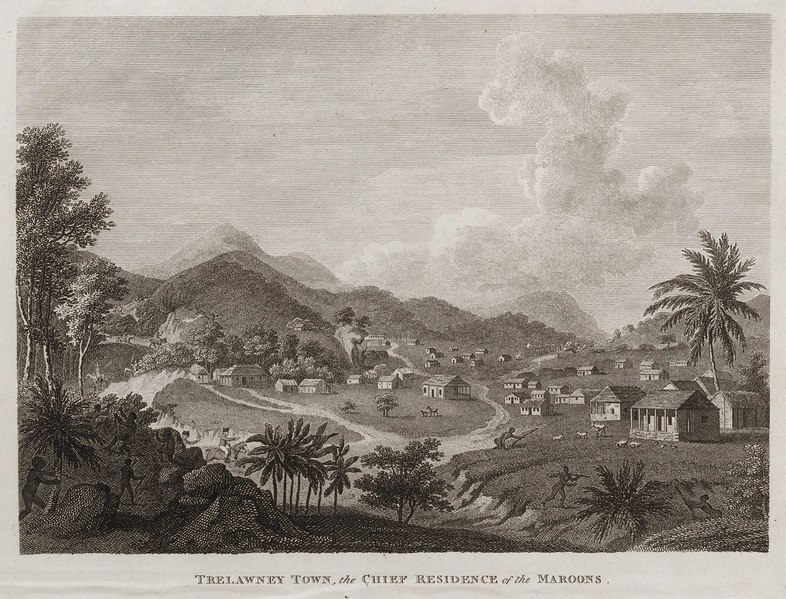
FIVE MAJOR TOWNS
-
- Accompong
- Trelawny Town
- Moore Town (formerly known as New Nanny Town)
- Scott’s Hall (Jamaica)
- Charles Town, Jamaica
- In exchange, they were requested not to harbour runaway Africans, but rather to assist in their capture. The treaty’s final paragraph provoked a schism between the Maroons and the rest of the Black people. Another agreement provision stated that the Maroons would protect the island from attackers. Dissatisfaction with the deal and planter land encroachment sparked the Second Maroon War.
Image Sources
Frequently Asked Questions
- What was the First Maroon War?
The First Maroon War occurred in the Colony of Jamaica from 1728 to 1739 between Maroon communities and British colonial forces.
- Who were the Maroons?
The Maroons were communities of escaped enslaved Africans who established free societies in the mountains and forests of Jamaica, resisting slavery and British colonial rule.
- What led to the outbreak of the First Maroon War?
Tensions between the Maroons and the British authorities escalated due to disputes over land, freedom, and the mistreatment of the Maroons by the planters.
